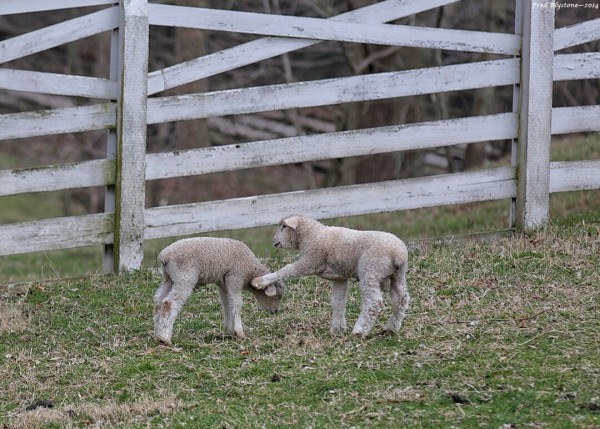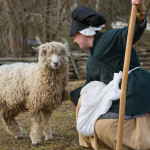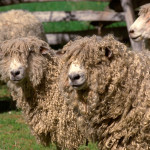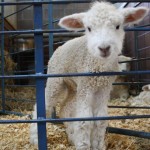
More than two decades ago, the first Leicester Longwool Sheep arrived in the Revolutionary City, and since then, Colonial Williamsburg has worked hard to preserve them. I spoke to Layne Anderson with Coach & Livestock about the breeding and birthing process needed to keep this particular type of sheep alive.
Last February, we shared a lot of great information about the breed as we celebrated its 25th anniversary in Williamsburg and the first lambs of the season. It turns out not only were the first two born last year twin girls, the first lambs born this year are also twin girls! If you haven’t already, be sure to submit your names for our contest.
I’ve always been enthralled by livestock. I know a lot of people have a passion for dogs and cats, and while I’m an animal lover of all kinds, I’m more of a cow and horse kind of girl. I particularly love our oxen (I help take care of Duke and Dan over at Great Hopes Plantation on the weekends). And the sheep crack me up. One of the items on my bucket list is assisting with a livestock birth, and I don’t know too many people who have something like that on theirs.
The birthing process fascinates me, and it makes me happy to know we breed our own sheep. Layne told me we typically breed anywhere from 15 to 20 ewes and most of the sheep in our flock were born and raised right here in Williamsburg. In September or October, after keeping the ewes and rams separate for most of the year, one ram is matched with four to six ewes, with the groups chosen “based on each individuals’ pedigree as well as how closely they match the breed standard.” What does that mean, exactly? We don’t just throw them together and see what happens. A lot of work and planning goes into the selection process. The groups remain together for about a month and a half, “roughly two estrous cycles.” That’s a sheep’s reproductive cycle. That’s when the ram is then removed from the group.
Fun fact: the groups are paired with another ram referred to as the “clean-up ram,” whose job is to impregnate the ewes in case the first ram wasn’t successful. This usually happens in December or January.
I heard a rumor that some type of marking is used to indicate whether a sheep has mated. Layne told me sometimes Coach & Livestock uses what’s called a marking harness on the ram, which is a belt with a grease crayon attached. If the ram mates with the ewe, a mark is made on the ewe’s back. This is not a typical practice for the team, as it’s not a historically accurate breeding practice, so most of the time, they let things go the natural route. “It makes lambing time a bit more of a surprise, but it keeps our shepherding skills sharp!” she told me.
The team has also used artificial insemination in the past and I’m told they may bring it back in the future. Layne said one benefit is that it allows them to add new genetic material from rams in different countries such as England, New Zealand, and Australia.
When a ewe gets pregnant, gestation lasts about five months and births can begin as early as February (like last year) or as late as May. Most of the lambs, however, are born in March and April. When a ewe is close to going into labor, her udder begins to swell with milk. At that time, she is moved to what we call our “maternity ward” in the pasture behind Wetherburn’s Tavern. Coach & Livestock monitors all of the ewes closely for lambing signs such as not coming in to eat and standing up and laying down repeatedly. (Did you know some ewes will give birth while standing while others will lay down?).
Once the lambs are born, they are immediately taken back to the stables. There, the team makes sure mama and her babies bond and the ewe is able to produce milk. Over the next few days, our staff will keep an eye on both the mother and lamb to ensure they are healthy and happy before moving them to a pasture. This time is also when they give the lamb vaccines, attach its ear tag, and dock its tail.
There are some cases in which the lamb needs to be bottle fed. In cases of multiple births (which are not uncommon in the breed), sometimes the ewe doesn’t make enough milk for all the babies. In those cases, the lambs need to be bottle-fed one to two times a day. If the ewe can’t produce milk at all, the team must bottle-feed the lambs constantly, but mama the stays with them. In the rare instances when a ewe rejects her lamb, the Coach & Livestock team takes care of the baby full time.
After a year, the lambs are called “yearlings” and will be referred to as such until they are about two years of age. Layne said they can also sometimes be called a hogget, shearling, teg, gimmer, or theave during that time.
If you’re like me and want to try your hand at witnessing a live birth, head over to the pasture behind Weatherburn’s Tavern, where you never know what will happen! Layne told me they were lucky enough to have this happen during one of their Rare Breeds talks this year! And we love pictures, so be sure to tag us on social media and use #CWRareBreeds and #SheepWeek. Speaking of pictures, a special thank you to Fred Blystone for the images we shared in today’s blog.



This reminds me of all the James Harriot books, which I and my daughters have read. “Lambing season” was his busiest and most inconvenient season. Hum, maybe it’s time to re read those great books.